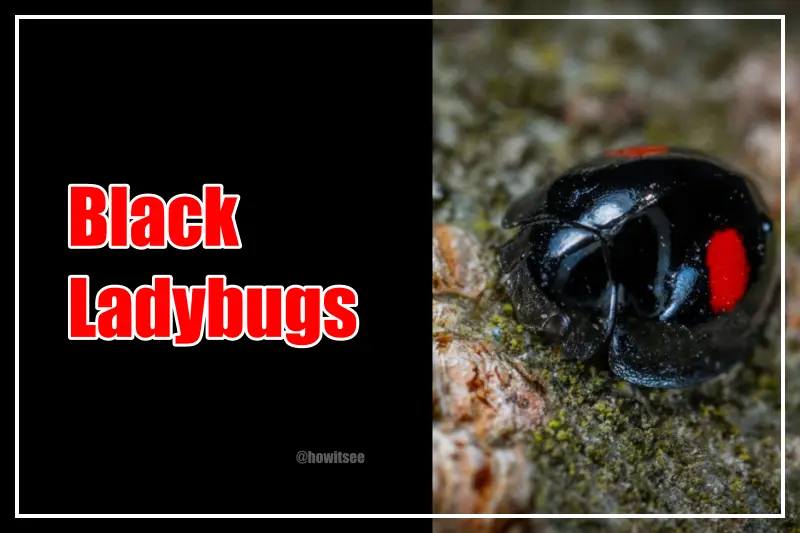You must have seen a ladybug once. Do you know that all the ladybugs are not red with black spots? There are also black ladybugs that exist in nature. These creatures are small and beautiful, yet distinctive in appearance. They are not as common as red ladybugs, but they are beneficial for the environment.
They may appear poisonous because of their aposematic coloration, but they are not. We will discuss these black ladybugs in this article. Here is a list of 15 black ladybugs found in nature with different color patterns.
15 Black Ladybugs With Different Color Patterns
1. Pine Ladybird

| Scientific name | Exochomus quadripustulatus |
| Size | 4-6 mm |
| Identification | Black wings with two red spots and two markings |
| Geographical location | Europe, Northern Asia (excluding China), and North America |
The pine ladybird or pine lady beetle are the common names for Exochomus quadripustulatus. Their coloration varies with age. Most are black with two red commas and two red circular spots.
They are beneficial for agriculturists and farmers as they feed on pests like aphids and scale insects. One can easily find them in the Palearctic realm, including Europe, Northern Asia, and North America. They are usually seen from April to October in deciduous forests.
2. Four-eyed Sigil Ladybird
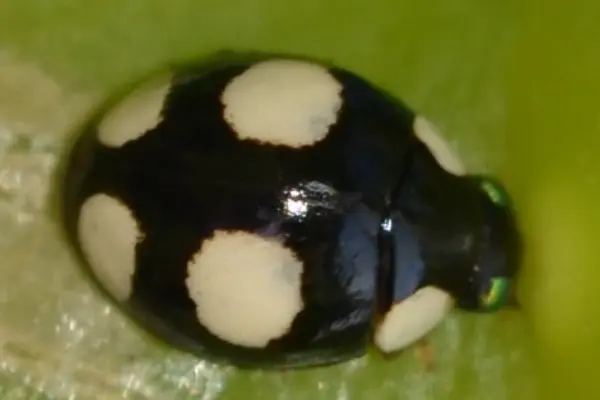
| Scientific name | Hyperaspis quadrioculata |
| Size | 2.7 to 4.0 mm |
| Identification | Black elytra with 4 orange spots |
| Geographical location | North America |
As their name indicates, they are known for their black elytra with four orange spots. They are small ladybugs with an average size of 2.7 to 4 mm.
It occurs across North America, mostly in woodlands. They are voracious predators and can eat large numbers of aphids. These black ladybugs are very common in late summer.
3. Lateral ladybeetle
| Scientific name | Hyperaspis Lateralis |
| Size | 2.5 to 3.8 mm |
| Identification | Black elytra with 1 to 3 yellow or red spots on each side |
| Geographical location | Central and North America |
Hyperaspis lateralis, the lateral lady beetle, is a species of lady beetle in the family Coccinellidae. These ladybugs are black and have 1 to 3 yellow or red spots on each side of their elytra.
They usually feed on mealybugs and scale insects that lay their eggs in a dense cottony mass called an ovisac. You can find these black ladybugs in Central and North America.
4. Harlequin ladybug
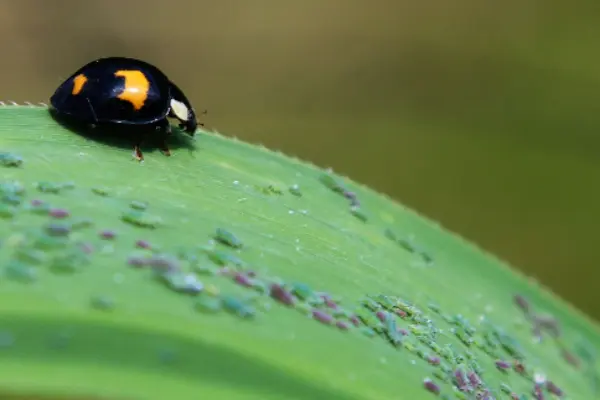
| Scientific name | Harmonia axyridis |
| Size | 5.5 to 8.5 mm |
| Identification | uniformly black with 2 or 4 red spots |
| Geographical location | Eastern Asia, North America, and Europe |
The Asian ladybeetle is also known as the harlequin ladybug because of its variable coloration. These ladybugs are medium-sized, with an average body size of 5.5 to 8.5 mm.
These multicolored bugs occur in many forms and have different colored spots, like red, orange, yellow, and black. The black forms of these Asian ladybeetles have black elytra with 2 or 4 red spots.
This species is native to Eastern Asia and was also introduced in North America and Europe to control pests like aphids.
5. Kidney spot ladybird
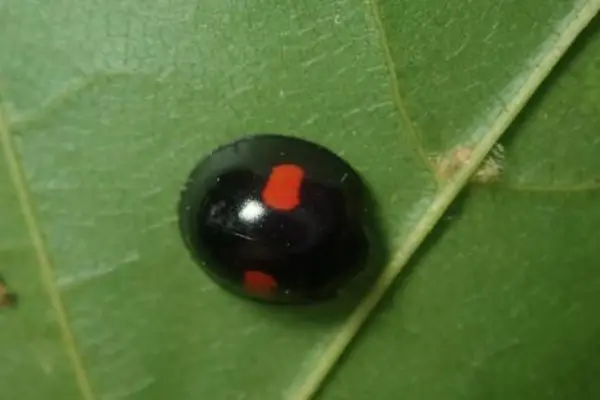
| Scientific name | Chilocorus renipustulatus |
| Size | 4 to 5 mm |
| Identification | black wings with two red spots |
| Geographical location | Europe, Asia, and Northern Africa |
This incredible bug, Chilocorus renipustulatus, belongs to the subfamily Chilocorinae and is commonly found in Europe, Asia, and Northern Africa.
These bugs are small, with sizes ranging from 4 to 5 mm. The kidney-spotted ladybugs are black with two red spots on their black elytra.
You can find these ladybugs in deciduous forests on trees like ash, oak, etc. during the winter. The larvae of this species are intimidating, with black bodies and long bristles.
6. Ten Spot Ladybird
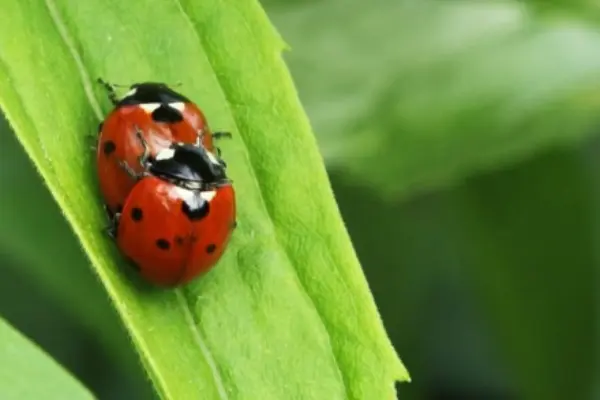
| Scientific name | Adalia decempunctata |
| Size | 3.5 to 5 mm |
| Identification | Black body with large red-orange markings |
| Geographical location | Europe, North Africa, European Russia, the Caucasus, Siberia, Belarus, Ukraine, Moldova, Transcaucasia, and Western Asia |
You can spot these ladybugs eating aphids in Europe, North Africa, European Russia, the Caucasus, Siberia, Belarus, Ukraine, Moldova, Transcaucasia, and Western Asia during all times of the year.
These ten spotted ladybirds are called so as they usually have 10 spots in their elytra; not always, but they range from 1 to 15.
They occur in many forms, but their chequered and melanic forms are black with large red-orange markings on their elytra. People often mistake them for harlequin ladybugs, as they have quite similar appearances.
7. Twice stabbed lady beetle
| Scientific name | Chilocorus stigma |
| Size | 5 mm |
| Identification | Black wings with two red spots |
| Geographical location | United States, Canada, and Hawaii |
This North American native ladybug species, Chilocorus stigma, is commonly known as the Twice-Stubbed Ladybeetle. These ladybugs are beautiful, with shiny black bodies and two red spots on the elytra.
When you saw these bugs from above, they appeared rounded and flat at the bottom. The most common type of bug found in the United States inhabits trees and shrubs and is sometimes mistaken for a Chilocorous orbus. They are multivoltine, which means they produce multiple generations in a year.
8. Cactus lady beetles
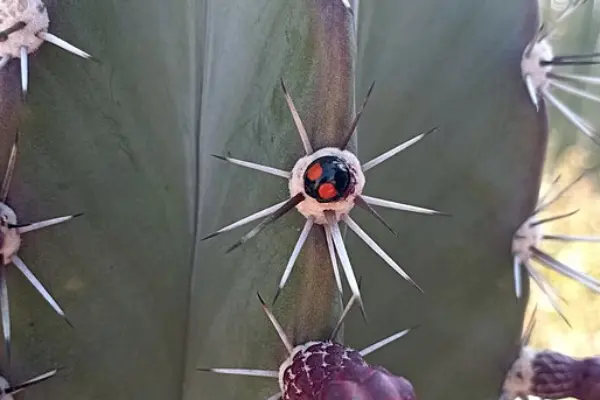
| Scientific name | Chilocorus cacti |
| Size | 6mm |
| Identification | Glossy black with reddish-brown spots |
| Geographical location | North, Central, and South America & the Caribbean |
Another ladybug on our list is the cactus lady beetle. They are used as biocontrol agents as their adults and larvae feed on scale insects. These ladybeetles have glossy black bodies with reddish-brown spots.
These bugs resemble Chilocorus stigma in size, shape, and pattern, except for the fact that their bottoms are brown instead of black. Their adult size can reach up to 6 mm.
9. Hieroglyphic Ladybug
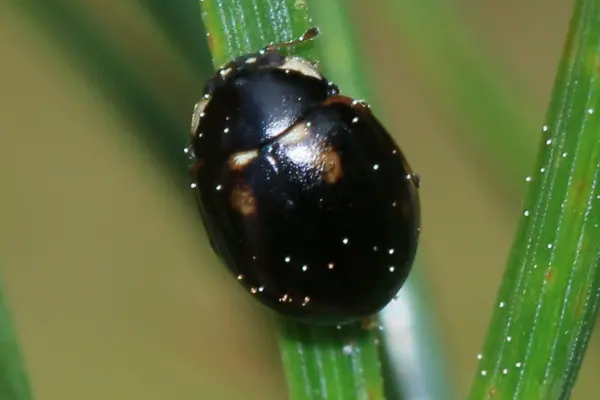
| Scientific name | Coccinella hieroglyphica |
| Size | 4 to 5 mm |
| Identification | black with yellow marks on their lateral sides |
| Geographical location | Europe, European Russia, Siberia, the Russian Far East, Belarus, Ukraine, Kazakhstan, Mongolia, China, Korea |
It is known as a hieroglyphic ladybug because its distinctive pattern of brownish-yellow stripes on its black elytra resembles Egyptian hieroglyphs. People can find them in a wide geographical range, including Europe, European Russia, Siberia, the Russian Far East, Belarus, Ukraine, Kazakhstan, Mongolia, China, and Korea.
They mostly prefer heathlands and acid grasslands. Talking about their appearance, they have 4 to 5-mm-long black bodies with distinct markings of brown or yellow.
10. Bigeminate Sigil lady beetle
| Scientific name | Hyperaspis bigeminata |
| Size | 2.3-3.4 mm |
| Identification | Black elytra with pale lateral markings and two red spots |
| Geographical location | North America |
The Bigeminate sigil lady beetle is small, with an average body size of 2.3 to 3.4 mm. As its name, Bigeminate (which means double twin-spotted), indicates, it has a black body with two pale lateral markings and two red spots in its elytra.
This deciduous-inhabited species usually feeds on crape myrtle. You can easily find these bugs in the early summers in North America, from the United States to Canada.
11. Kuwana’s Lady Beetle
| Scientific name | Chilocorus kuwanae |
| Size | 3.0 to 4.75 mm |
| Identification | Black elytra with two squared red spots |
| Geographical location | Europe, Northern Asia (excluding China), and Southern Asia |
Another species of the genus Chilocorus is Kuwana’s lady beetle. They have a similar appearance to any twice-stabbed lady beetle. They have a black body and an elytra with two red spots.
It can be easily distinguished from square spots instead of round spots. These bugs are imported from Korea to several parts of the world, like Europe, etc., to control pest species.
12. Ursine spur leg lady beetle
| Scientific name | Brachiacantha ursina |
| Size | 3.0 to 4.0 mm |
| Identification | Black with 5 orange spots on each side |
| Geographical location | North America |
These bugs are small and can attain a size of 3 to 4 mm. They have a black pronotum with five orange spots on each elytra. Their larvae are unique, with alligator-like shapes and black, flexible spines all over the body.
They are commonly found in North America, inhabiting crop fields, woodlands, and meadows. They mostly feed on aphids, mites, caterpillars, insect eggs, and soft-bodied insects.
13. Yellow-shouldered ladybird

| Scientific name | Apolinus lividigaster |
| Size | 3 mm |
| Identification | Black with yellow spots on the thorax |
| Geographical location | Australia and New Zealand |
Apolinus lividigaster is commonly known as the yellow-shouldered ladybird. They are bluish-black with two yellow spots on the thorax, and fine yellow-white feathers are also present all over the body.
It mostly feeds on cowpea aphids and milkweed aphids. They are very small, with an average size of 3 mm. This distinctive species is only found in Australia and New Zealand. It is one of the few ladybird species that can produce sound by rubbing its abdomen against its elytra.
14. Twice-struck lady beetle
| Scientific name | Axion Plagiatum |
| Size | 5.6-6.4 mm |
| Identification | Black with two large red spots |
| Geographical location | the Caribbean and North America |
Twice-struck beetle Axion Plagiatum resembles the two-stabbed ladybeetle. These beetles also have a shiny black body with two large yellow or red spots, just like two stabbed lady beetles.
These ladybugs are round from above and flat from the bottom. They are commonly found in the Caribbean and North America, inhabiting open and semi-open habitats like gardens, fields, forests, etc.
15. Thrice struck lady beetle
| Scientific name | Axion tripustulatum |
| Size | 5-7 mm |
| Identification | Black with three red spots |
| Geographical location | North America |
The three-struck lady beetle Axion tripustulatum got its name from the three red spots present on their black bodies. These species have red marks on the lateral sides and in the middle of both elytra. Because of their insect-predatory nature, they are used as biocontrol agents in agriculture.
In this article, you get to know about different black ladybugs that need our attention and admiration. These ladybugs are unique not just by appearance but also by their behavior.
Black is often considered unlucky or evil, but these black ladybugs are a sign of health, strength, and vitality. I hope you like this post about 15 black ladybugs with different color patterns.
Also Read:

Being a zoology student I’m always been fascinated toward animals especially insects. I love to do research and learn about different animals. As a writer I want to share my thoughts about nature through my articles. Apart from this you can find me exploring the new places and voice notes.
